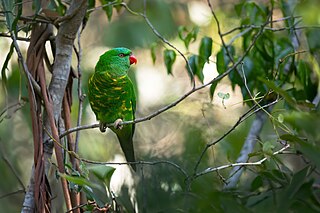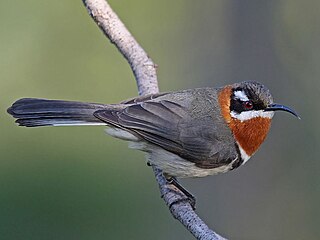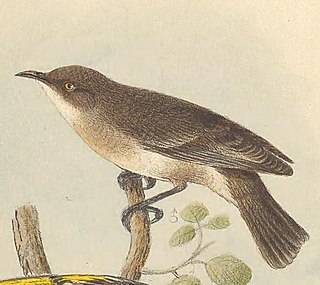
The red wattlebird is a passerine bird native to southern Australia. At 33–37 cm in length, it is the second largest species of Australian honeyeater. It has mainly grey-brown plumage, with red eyes, distinctive pinkish-red wattles on either side of the neck, white streaks on the chest and a large bright yellow patch on the lower belly. The sexes are similar in plumage. Juveniles have less prominent wattles and browner eyes. John White described the red wattlebird in 1790. Three subspecies are recognized.

The scaly-breasted lorikeet is an Australian lorikeet found in woodland in eastern Australia. The common name aptly describes this bird, which has yellow breast feathers broadly edged with green that look like scales.

The blue-faced honeyeater, also colloquially known as the bananabird, is a passerine bird of the honeyeater family, Meliphagidae. It is the only member of its genus, and it is most closely related to honeyeaters of the genus Melithreptus. Three subspecies are recognised. At around 29.5 cm (11.6 in) in length, the blue-faced species is large for a honeyeater. Its plumage is distinctive, with olive upperparts, white underparts, and a black head and throat with white nape and cheeks. Males and females are similar in external appearance. Adults have a blue area of bare skin on each side of the face readily distinguishing them from juveniles, which have yellow or green patches of bare skin.

The noisy friarbird is a passerine bird of the honeyeater family Meliphagidae native to southern New Guinea and eastern Australia. It is one of several species known as friarbirds whose heads are bare of feathers. It is brown-grey in colour, with a prominent knob on its bare black-skinned head. It feeds on insects and nectar.

Lewin's honeyeater is a bird that inhabits the ranges along the east coast of Australia. It has a semicircular ear-patch, pale yellow in colour.

The scarlet myzomela or scarlet honeyeater is a small passerine bird of the honeyeater family Meliphagidae native to Australia. It was first described by English ornithologist John Latham in 1801. At 9 to 11 cm long, it is the smallest honeyeater in Australia. It has a short tail and relatively long down-curved bill. It is sexually dimorphic; the male is a striking bright red with black wings, while the female is entirely brown. The species is more vocal than most honeyeaters, and a variety of calls have been recorded, including a bell-like tinkling.

The white-plumed honeyeater is a small passerine bird endemic to Australia. White-plumed honeyeaters are common around water and are often seen in backyards and suburbs with vegetation cover.

The yellow-faced honeyeater is a small to medium-sized bird in the honeyeater family, Meliphagidae. It takes its common and scientific names from the distinctive yellow stripes on the sides of its head. Its loud, clear call often begins twenty or thirty minutes before dawn. It is widespread across eastern and southeastern Australia, in open sclerophyll forests from coastal dunes to high-altitude subalpine areas, and woodlands along creeks and rivers. Comparatively short-billed for a honeyeater, it is thought to have adapted to a diet of flies, spiders, and beetles, as well as nectar and pollen from the flowers of plants, such as Banksia and Grevillea, and soft fruits. It catches insects in flight as well as gleaning them from the foliage of trees and shrubs.

The white-cheeked honeyeater inhabits the east coast and the south-west corner of Australia. It has a large white patch on its cheek, brown eyes, and a yellow panel on its wing.

The western spinebill is a honeyeater found in the heath and woodland of south-western Australia. Ranging between 12–16 centimetres (4.7–6.3 in) long, it weighs around 10 grams (0.35 oz). It has a black head, gray back and wings, with a red band behind its neck and from its throat to its breast. Its curved bill is long and slender.

The striped honeyeater is a passerine bird of the honeyeater family, Meliphagidae, found in Australia. It is a medium-sized honeyeater, about 23 cm (9.1 in) in length. Both sexes are a light greyish brown with dark brown centres to the feathers, which give the appearance of stripes. The stripes are particularly distinct on the head and back of the neck. While it is found mainly in inland eastern Australia where it inhabits the drier open forest, it is also found in coastal swamp forest from southeast Queensland to the central coast of New South Wales.

The spiny-cheeked honeyeater is the only species in the genus Acanthagenys. It is large for a honeyeater, ranging from 22 to 27 centimeters tall and weighing around 52 grams. The birds are sociable, aggressive, and often observed foraging in large flocks.

The grey honeyeater is a species of bird in the honeyeater family. It is an uncommon and little-known bird, an often overlooked endemic of remote areas in central Australia.

The crescent honeyeater is a passerine bird of the honeyeater family Meliphagidae native to southeastern Australia. A member of the genus Phylidonyris, it is most closely related to the common New Holland honeyeater and the white-cheeked honeyeater. Two subspecies are recognized, with P. p. halmaturinus restricted in range to Kangaroo Island and the Mount Lofty Ranges in South Australia.

The painted honeyeater is a species of honeyeater in a monotypic genus.

The grey-headed honeyeater is a species of bird in the family Meliphagidae. It is endemic to Australia.


















